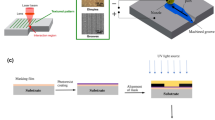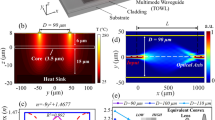Abstract
We demonstrate a DNA-based optical fiber device that uses an in-fiber grating, a light absorbing coating with surface anchored DNA, and a built-in optical thermometer. This device is used for precisely thermal cycling surface DNA spots bound by a simple UV cross-linking technique. Near-infrared light of wavelengths near 1550 nm and guided power near 300 mW is coupled out of the fiber core by a tilted fiber Bragg grating inscribed in the fiber and absorbed by the coating to increase its temperature to more than 95 °C. A co-propagating broadband light signal (also in the near-infrared region) is used to measure the reflection spectrum of the grating and thus the temperature from the wavelength shifts of the reflection peaks. The device is capable of sensitive DNA melt analysis and can be used for DNA amplification.

Graphical abstract






Similar content being viewed by others
References
Wang X, Wolfbeis OS. Fiber-optic chemical sensors and biosensors (2013–2015). Anal Chem. 2016;88(1):203–27.
Daems D, Knez K, Delport F, Spasic D, Lammertyn J. Real-time PCR melting analysis with fiber optic SPR enables multiplex DNA identification of bacteria. Analyst. 2016;141(6):1906–11.
Nguyen L, Giannetti S, Warren-Smith S, Cooper A, Selleri S, Cucinotta A, et al. Genotyping single nucleotide polymorphisms using different molecular beacon multiplexed within a suspended core optical fiber. Sensors. 2014;14(8):14488–99.
Sun D, Guo T, Ran Y, Huang Y, Guan B-O. In-situ DNA hybridization detection with a reflective microfiber grating biosensor. Biosens Bioelectron. 2014;61:541–6.
Bertucci A, Manicardi A, Candiani A, Giannetti S, Cucinotta A, Spoto G, et al. Detection of unamplified genomic DNA by a PNA-based microstructured optical fiber (MOF) Bragg-grating optofluidic system. Biosens Bioelectron. 2015;63:248–54.
Wang X, Dong X, Zhou Y, Ni K, Cheng J, Chen Z. Hot-wire anemometer based on silver-coated fiber Bragg grating assisted by no-core fiber. IEEE Photon Technol Lett. 2013;25(24):2458–61.
Cashdollar LJ, Chen KP. Fiber Bragg grating flow sensors powered by in-fiber light. IEEE Sens J. 2005;5(6):1327–31.
Wang X, Dong X, Zhou Y, Li Y, Cheng J, Chen Z. Optical fiber anemometer using silver-coated fiber Bragg grating and bitaper. Sens Actuators A. 2014;214:230–3.
Caldas P, Jorge PAS, Rego G, Frazão O, Santos JL, Ferreira LA, et al. Fiber optic hot-wire flowmeter based on a metallic coated hybrid long period grating/fiber Bragg grating structure. Appl Opt. 2011;50(17):2738.
Dong X, Zhou Y, Zhou W, Cheng J, Su Z. Compact anemometer using silver-coated fiber Bragg grating. IEEE Photon J. 2012;4(5):1381–6.
Kashayap R. Fiber Bragg gratings. Academic Press; 2010.
Albert J, Shao L-Y, Caucheteur C. Tilted fiber Bragg grating sensors. Laser Photon Rev. 2013;7(1):83–108.
Carver GE, Koch TR, Salvemini D, Feder KS, Westbrook PS. A fiber-grating-based distributed light source. Photon Sens Technol. 2006;6371:63710H.
Hoffmann J, Hin S, Von SF, Zengerle R, Roth G. Universal protocol for grafting PCR primers onto various lab-on-a-chip substrates for solid-phase PCR. RSC Adv. 2012;2(9):3885.
Adessi C. Solid phase DNA amplification: characterisation of primer attachment and amplification mechanisms. Nucleic Acids Res. 2000;28(20):e87e.
Gudnason H, Dufva M, Duong Bang D, Wolff A. An inexpensive and simple method for thermally stable immobilization of DNA on an unmodified glass surface: UV linking of poly(T)10-poly(C)10-tagged DNA probes. Biotechniques. 2008;45(3):261–71.
Wang Z, Zong S, Yang J, Li J, Cui Y. Dual-mode probe based on mesoporous silica coated gold nanorods for targeting cancer cells. Biosens Bioelectron. 2011;26(6):2883–9.
Mega JL, Close SL, Wiviott SD, Shen L, Walker JR, Simon T, et al. Genetic variants in ABCB1 and CYP2C19 and cardiovascular outcomes after treatment with clopidogrel and prasugrel in the TRITON-TIMI 38 trial: a pharmacogenetic analysis. Lancet. 2010;376(9749):1312–9.
Alqarni SA, Albert J, Smelser CW. Fiber-grating-based hyperthermal therapeutic device for mm-sized ex vivo Lethal Volume. In: Advanced photonics 2018 (BGPP, IPR, NP, NOMA, sensors, networks, SPPCom, SOF). Washington: Optical Society of America; 2018. p. SeM2E.4.
Pollet J, Janssen KPF, Knez K, Lammertyn J. Real-time monitoring of solid-phase PCR using fiber-optic SPR. Small. 2011;7(8):1003–6.
Gao S, Zhang AP, Tam H-Y, Cho LH, Lu C. All-optical fiber anemometer based on laser heated fiber Bragg gratings. Opt Express. 2011;19(11):10124–30.
Ge D, Wang X, Williams K, Levicky R. Thermostable DNA immobilization and temperature effects on surface hybridization. Langmuir. 2012;28(22):8446–55.
Gudnason H, Dufva M, Bang DD, Wolff A. Comparison of multiple DNA dyes for real-time PCR: effects of dye concentration and sequence composition on DNA amplification and melting temperature. Nucleic Acids Res. 2007;35(19):e127.
Eischeid AC. SYTO dyes and EvaGreen outperform SYBR Green in real-time PCR. BMC Res Notes. 2011;4(1):263.
Delport F, Pollet J, Janssen K, Verbruggen B, Knez K, Spasic D, et al. Real-time monitoring of DNA hybridization and melting processes using a fiber optic sensor. Nanotechnology. 2012;23(6):065503.
Farrar JS, Wittwer CT. Extreme PCR: efficient and specific DNA amplification in 15-60 seconds. Clin Chem. 2015;61(1):145–53.
Montgomery JL, Wittwer CT. Influence of PCR reagents on DNA polymerase extension rates measured on real-time PCR instruments. Clin Chem. 2014;60(2):334–40.
Shin Y, Perera AP, Kim KW, Park MK. Real-time, label-free isothermal solid-phase amplification/detection (ISAD) device for rapid detection of genetic alteration in cancers. Lab Chip. 2013;13(11):2106–14.
Kersting S, Rausch V, Bier FF, von Nickisch-Rosenegk M. Multiplex isothermal solid-phase recombinase polymerase amplification for the specific and fast DNA-based detection of three bacterial pathogens. Mikrochim Acta. 2014;181(13–14):1715–23.
Acknowledgements
This work was funded by grants from the Natural Sciences and Engineering Research Council of Canada and Spartan Biosciences Inc. Gratings were fabricated in the Advanced Photonics Laboratory of Carleton University by Albane Laronche.
Author information
Authors and Affiliations
Corresponding author
Ethics declarations
This research does not involve any human participants or animals.
Conflict of interest
The authors declare that they have no competing interests.
Additional information
Publisher’s note
Springer Nature remains neutral with regard to jurisdictional claims in published maps and institutional affiliations.
Electronic supplementary material
ESM 1
(PDF 798 kb)
Rights and permissions
About this article
Cite this article
Koppert, J., Jean-Ruel, H., O’Neill, D. et al. Self-heating tilted fiber Bragg grating device for melt curve analysis of solid-phase DNA hybridization and thermal cycling. Anal Bioanal Chem 411, 6813–6823 (2019). https://doi.org/10.1007/s00216-019-02072-x
Received:
Revised:
Accepted:
Published:
Issue Date:
DOI: https://doi.org/10.1007/s00216-019-02072-x




